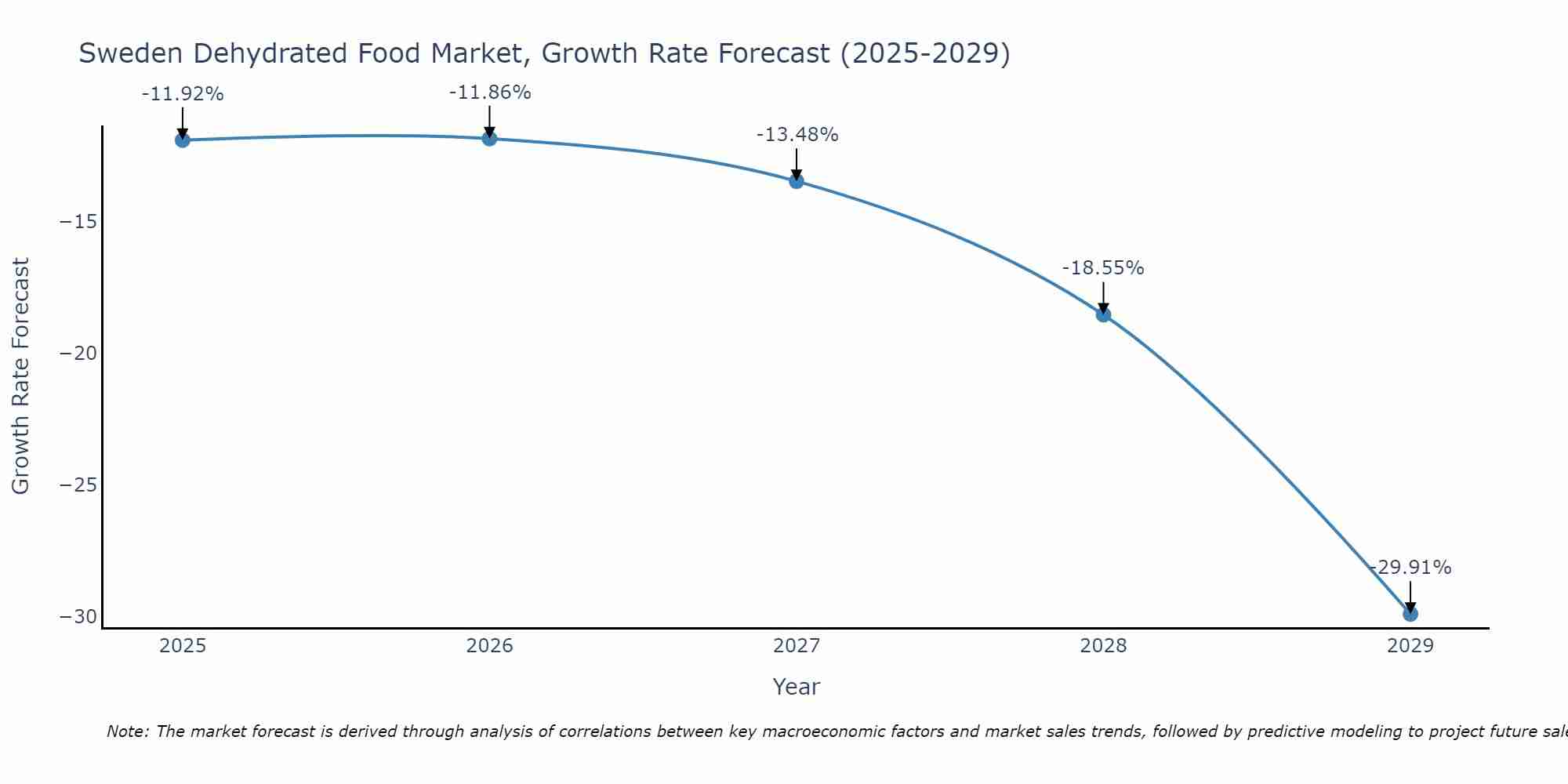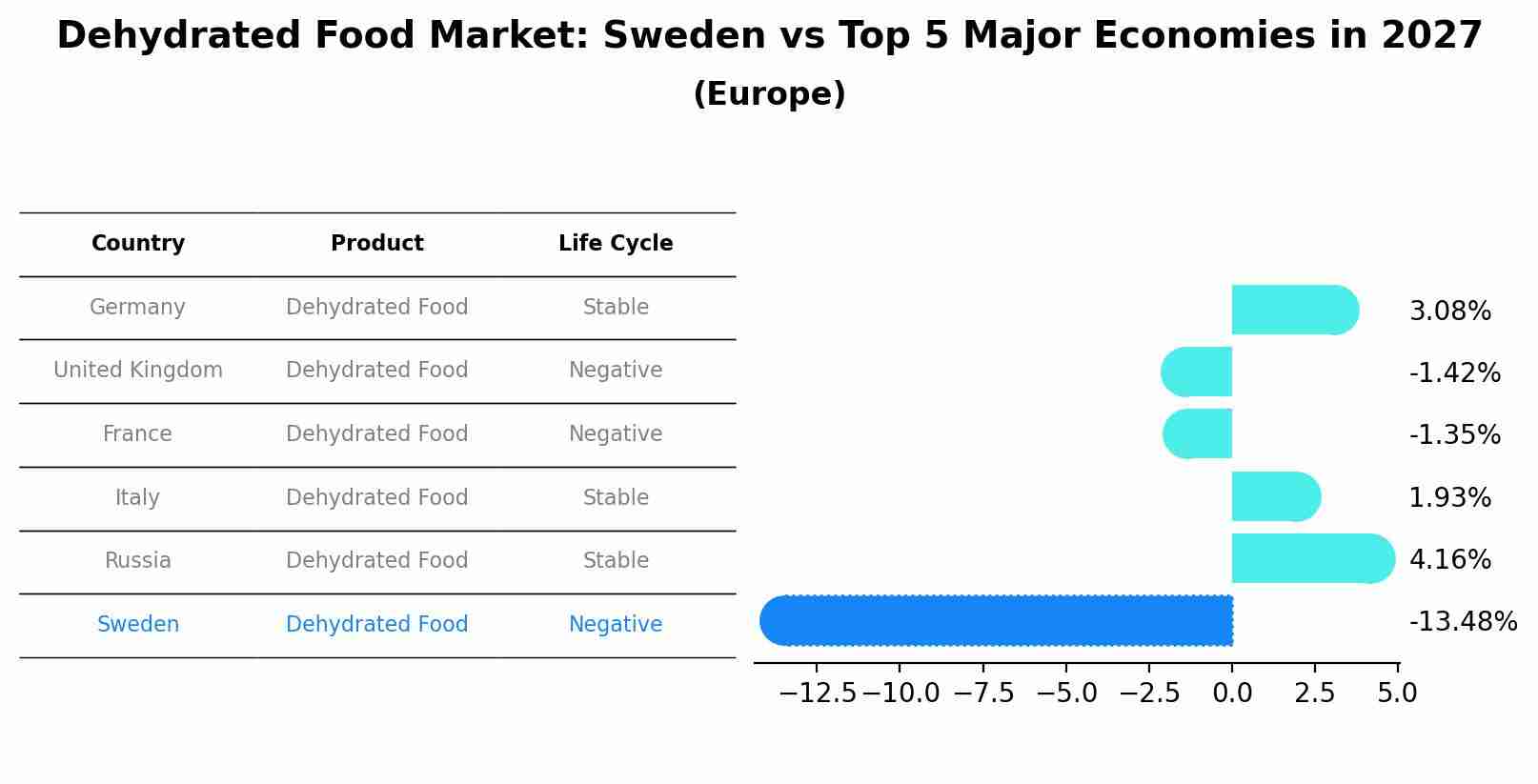Sweden Dehydrated Food Market (2025-2031) | Outlook, Forecast, Trends, Companies, Segmentation, Value, Growth, Revenue, Analysis, Industry, Size & Share
| Product Code: ETC4837318 | Publication Date: Nov 2023 | Updated Date: Apr 2025 | Product Type: Market Research Report | |
| Publisher: 6Wresearch | Author: Sachin Kumar Rai | No. of Pages: 60 | No. of Figures: 30 | No. of Tables: 5 |
Sweden Dehydrated Food Market Size Growth Rate
The Sweden Dehydrated Food Market is projected to witness mixed growth rate patterns during 2025 to 2029. Starting at -11.92% in 2025, the market peaks at -11.86% in 2026, and settles at -29.91% by 2029.

Dehydrated Food Market: Sweden vs Top 5 Major Economies in 2027 (Europe)
By 2027, the Dehydrated Food market in Sweden is anticipated to reach a growth rate of -13.48%, as part of an increasingly competitive Europe region, where Germany remains at the forefront, supported by United Kingdom, France, Italy and Russia, driving innovations and market adoption across sectors.

Sweden Dehydrated Food Market Overview
Swedens dehydrated food market is expanding due to the rising demand for convenient, long-lasting food products. Dehydrated foods are popular in both the retail and foodservice sectors for their extended shelf life and ease of storage. As consumer preferences shift toward ready-to-eat and healthy food options, this market continues to grow.
Drivers of the market
The Sweden Dehydrated Food Market is influenced by the rising demand for convenient and long-lasting food products. As consumers seek healthier and more sustainable options, dehydrated foods offer a viable solution for maintaining nutrition while extending shelf life. The growing trend of outdoor activities, such as camping and hiking, also boosts the demand for dehydrated food products, driving market growth.
Challenges of the market
The Sweden Dehydrated Food Market faces challenges related to consumer perceptions of dehydrated foods. Many consumers still associate dehydrated products with inferior quality compared to fresh foods, which can hinder market growth. Additionally, the market is affected by fluctuations in raw material availability, impacting production schedules and pricing. Furthermore, stringent food safety regulations necessitate rigorous quality control measures, which can increase operational costs for manufacturers.
Government Policy of the market
The Dehydrated Food Market in Sweden is influenced by government policies that promote food security and sustainable agriculture. The Swedish government supports initiatives aimed at reducing food waste and enhancing food preservation methods, leading to increased demand for dehydrated food products. Regulations promoting healthy eating and the use of natural ingredients in food products also drive market growth. Additionally, the government encourages research and development in food processing technologies, fostering innovation within the dehydrated food sector.
Key Highlights of the Report:
- Sweden Dehydrated Food Market Outlook
- Market Size of Sweden Dehydrated Food Market, 2024
- Forecast of Sweden Dehydrated Food Market, 2031
- Historical Data and Forecast of Sweden Dehydrated Food Revenues & Volume for the Period 2021-2031
- Sweden Dehydrated Food Market Trend Evolution
- Sweden Dehydrated Food Market Drivers and Challenges
- Sweden Dehydrated Food Price Trends
- Sweden Dehydrated Food Porter`s Five Forces
- Sweden Dehydrated Food Industry Life Cycle
- Historical Data and Forecast of Sweden Dehydrated Food Market Revenues & Volume By Type for the Period 2021-2031
- Historical Data and Forecast of Sweden Dehydrated Food Market Revenues & Volume By Spray-dried for the Period 2021-2031
- Historical Data and Forecast of Sweden Dehydrated Food Market Revenues & Volume By Freeze-dried for the Period 2021-2031
- Historical Data and Forecast of Sweden Dehydrated Food Market Revenues & Volume By Vacuum-dried for the Period 2021-2031
- Historical Data and Forecast of Sweden Dehydrated Food Market Revenues & Volume By Drum-dried for the Period 2021-2031
- Historical Data and Forecast of Sweden Dehydrated Food Market Revenues & Volume By Others for the Period 2021-2031
- Historical Data and Forecast of Sweden Dehydrated Food Market Revenues & Volume By Product for the Period 2021-2031
- Historical Data and Forecast of Sweden Dehydrated Food Market Revenues & Volume By Dried Processed Food for the Period 2021-2031
- Historical Data and Forecast of Sweden Dehydrated Food Market Revenues & Volume By Dried Fruit & Vegetable for the Period 2021-2031
- Historical Data and Forecast of Sweden Dehydrated Food Market Revenues & Volume By Dried Dairy for the Period 2021-2031
- Historical Data and Forecast of Sweden Dehydrated Food Market Revenues & Volume By Dried Meat & Seafood for the Period 2021-2031
- Historical Data and Forecast of Sweden Dehydrated Food Market Revenues & Volume By Others for the Period 2021-2031
- Historical Data and Forecast of Sweden Dehydrated Food Market Revenues & Volume By Distribution Channel for the Period 2021-2031
- Historical Data and Forecast of Sweden Dehydrated Food Market Revenues & Volume By Hypermarket/Supermarket for the Period 2021-2031
- Historical Data and Forecast of Sweden Dehydrated Food Market Revenues & Volume By Convenience Stores for the Period 2021-2031
- Historical Data and Forecast of Sweden Dehydrated Food Market Revenues & Volume By Online Retailing for the Period 2021-2031
- Historical Data and Forecast of Sweden Dehydrated Food Market Revenues & Volume By Others for the Period 2021-2031
- Sweden Dehydrated Food Import Export Trade Statistics
- Market Opportunity Assessment By Type
- Market Opportunity Assessment By Product
- Market Opportunity Assessment By Distribution Channel
- Sweden Dehydrated Food Top Companies Market Share
- Sweden Dehydrated Food Competitive Benchmarking By Technical and Operational Parameters
- Sweden Dehydrated Food Company Profiles
- Sweden Dehydrated Food Key Strategic Recommendations
Frequently Asked Questions About the Market Study (FAQs):
1 Executive Summary |
2 Introduction |
2.1 Key Highlights of the Report |
2.2 Report Description |
2.3 Market Scope & Segmentation |
2.4 Research Methodology |
2.5 Assumptions |
3 Sweden Dehydrated Food Market Overview |
3.1 Sweden Country Macro Economic Indicators |
3.2 Sweden Dehydrated Food Market Revenues & Volume, 2021 & 2031F |
3.3 Sweden Dehydrated Food Market - Industry Life Cycle |
3.4 Sweden Dehydrated Food Market - Porter's Five Forces |
3.5 Sweden Dehydrated Food Market Revenues & Volume Share, By Type, 2021 & 2031F |
3.6 Sweden Dehydrated Food Market Revenues & Volume Share, By Product, 2021 & 2031F |
3.7 Sweden Dehydrated Food Market Revenues & Volume Share, By Distribution Channel, 2021 & 2031F |
4 Sweden Dehydrated Food Market Dynamics |
4.1 Impact Analysis |
4.2 Market Drivers |
4.3 Market Restraints |
5 Sweden Dehydrated Food Market Trends |
6 Sweden Dehydrated Food Market Segmentations |
6.1 Sweden Dehydrated Food Market, By Type |
6.1.1 Overview and Analysis |
6.1.2 Sweden Dehydrated Food Market Revenues & Volume, By Spray-dried, 2021-2031F |
6.1.3 Sweden Dehydrated Food Market Revenues & Volume, By Freeze-dried, 2021-2031F |
6.1.4 Sweden Dehydrated Food Market Revenues & Volume, By Vacuum-dried, 2021-2031F |
6.1.5 Sweden Dehydrated Food Market Revenues & Volume, By Drum-dried, 2021-2031F |
6.1.6 Sweden Dehydrated Food Market Revenues & Volume, By Others, 2021-2031F |
6.2 Sweden Dehydrated Food Market, By Product |
6.2.1 Overview and Analysis |
6.2.2 Sweden Dehydrated Food Market Revenues & Volume, By Dried Processed Food, 2021-2031F | 6.2.3 Sweden Dehydrated Food Market Revenues & Volume, By Dried Fruit & Vegetable, 2021-2031F |
6.2.4 Sweden Dehydrated Food Market Revenues & Volume, By Dried Dairy, 2021-2031F |
6.2.5 Sweden Dehydrated Food Market Revenues & Volume, By Dried Meat & Seafood, 2021-2031F |
6.2.6 Sweden Dehydrated Food Market Revenues & Volume, By Others, 2021-2031F |
6.3 Sweden Dehydrated Food Market, By Distribution Channel |
6.3.1 Overview and Analysis |
6.3.2 Sweden Dehydrated Food Market Revenues & Volume, By Hypermarket/Supermarket, 2021-2031F |
6.3.3 Sweden Dehydrated Food Market Revenues & Volume, By Convenience Stores, 2021-2031F |
6.3.4 Sweden Dehydrated Food Market Revenues & Volume, By Online Retailing, 2021-2031F |
6.3.5 Sweden Dehydrated Food Market Revenues & Volume, By Others, 2021-2031F |
7 Sweden Dehydrated Food Market Import-Export Trade Statistics |
7.1 Sweden Dehydrated Food Market Export to Major Countries |
7.2 Sweden Dehydrated Food Market Imports from Major Countries |
8 Sweden Dehydrated Food Market Key Performance Indicators |
9 Sweden Dehydrated Food Market - Opportunity Assessment |
9.1 Sweden Dehydrated Food Market Opportunity Assessment, By Type, 2021 & 2031F |
9.2 Sweden Dehydrated Food Market Opportunity Assessment, By Product, 2021 & 2031F |
9.3 Sweden Dehydrated Food Market Opportunity Assessment, By Distribution Channel, 2021 & 2031F |
10 Sweden Dehydrated Food Market - Competitive Landscape |
10.1 Sweden Dehydrated Food Market Revenue Share, By Companies, 2024 |
10.2 Sweden Dehydrated Food Market Competitive Benchmarking, By Operating and Technical Parameters |
11 Company Profiles |
12 Recommendations | 13 Disclaimer |
- Single User License$ 1,995
- Department License$ 2,400
- Site License$ 3,120
- Global License$ 3,795
Search
Related Reports
- Portugal Electronic Document Management Market (2025-2031) | Strategy, Consumer Insights, Analysis, Investment Trends, Opportunities, Growth, Size, Share, Industry, Revenue, Segments, Value, Segmentation, Supply, Forecast, Restraints, Outlook, Competition, Drivers, Trends, Demand, Pricing Analysis, Competitive, Strategic Insights, Companies, Challenges
- France Electronic Document Management Market (2025-2031) | Strategy, Consumer Insights, Analysis, Investment Trends, Opportunities, Growth, Size, Share, Industry, Revenue, Segments, Value, Segmentation, Supply, Forecast, Restraints, Outlook, Competition, Drivers, Trends, Demand, Pricing Analysis, Competitive, Strategic Insights, Companies, Challenges
- Portugal Occupational Health & Safety Services Market (2025-2031) | Strategy, Consumer Insights, Analysis, Investment Trends, Opportunities, Growth, Size, Share, Industry, Revenue, Segments, Value, Segmentation, Supply, Forecast, Restraints, Outlook, Competition, Drivers, Trends, Demand, Pricing Analysis, Competitive, Strategic Insights, Companies, Challenges
- Netherlands Occupational Health and Safety Services Market (2025-2031) | Strategy, Consumer Insights, Analysis, Investment Trends, Opportunities, Growth, Size, Share, Industry, Revenue, Segments, Value, Segmentation, Supply, Forecast, Restraints, Outlook, Competition, Drivers, Trends, Demand, Pricing Analysis, Competitive, Strategic Insights, Companies, Challenges
- Belgium and Luxembourg Facility Management Market (2025-2031) | Strategy, Consumer Insights, Analysis, Investment Trends, Opportunities, Growth, Size, Share, Industry, Revenue, Segments, Value, Segmentation, Supply, Forecast, Restraints, Outlook, Competition, Drivers, Trends, Demand, Pricing Analysis, Competitive, Strategic Insights, Companies, Challenges
- Russia Women Intimate Apparel Market (2025-2031) | Strategy, Consumer Insights, Analysis, Investment Trends, Opportunities, Growth, Size, Share, Industry, Revenue, Segments, Value, Segmentation, Supply, Forecast, Restraints, Outlook, Competition, Drivers, Trends, Demand, Pricing Analysis, Competitive, Strategic Insights, Companies, Challenges
- Africa Chocolate Market (2025-2031) | Size, Share, Trends, Growth, Revenue, Analysis, Forecast, industry & Outlook
- Global Hydroxychloroquine And Chloroquine Market (2025-2031) | Industry, Trends, Size, Outlook, Growth, Value, Companies, Revenue, Analysis, Share, Forecast
- Saudi Arabia Plant Maintenance Market (2025-2031) | Industry, Size, Growth, Revenue, Value, Companies, Forecast, Analysis, Share & Trends
- Taiwan Electric Truck Market (2025-2031) | Outlook, Industry, Revenue, Size, Forecast, Growth, Analysis, Share, Companies, Value & Trends
Industry Events and Analyst Meet
Our Clients
Whitepaper
- Middle East & Africa Commercial Security Market Click here to view more.
- Middle East & Africa Fire Safety Systems & Equipment Market Click here to view more.
- GCC Drone Market Click here to view more.
- Middle East Lighting Fixture Market Click here to view more.
- GCC Physical & Perimeter Security Market Click here to view more.
6WResearch In News
- Doha a strategic location for EV manufacturing hub: IPA Qatar
- Demand for luxury TVs surging in the GCC, says Samsung
- Empowering Growth: The Thriving Journey of Bangladesh’s Cable Industry
- Demand for luxury TVs surging in the GCC, says Samsung
- Video call with a traditional healer? Once unthinkable, it’s now common in South Africa
- Intelligent Buildings To Smooth GCC’s Path To Net Zero













